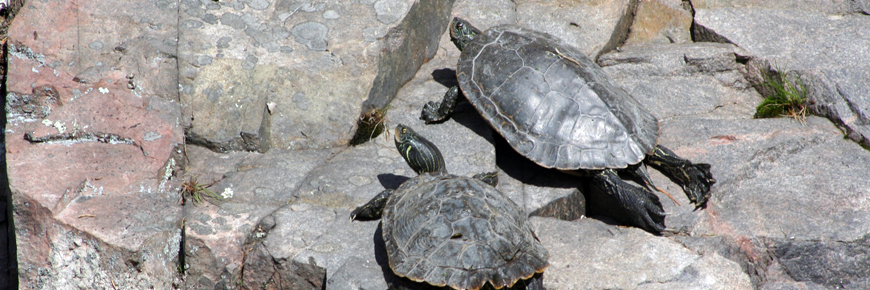
Wildlife Viewing
Thousand Islands National Park
From families of basking turtles to soaring birds of prey, the opportunities to view wildlife in Thousand Islands National Park are excellent. The top 5 common wildlife species visitors may spot when at the park are osprey, map turtles, mink, great blue herons, and white-tailed deer.
Get up with the sun to take in a chorus of songbirds advertising for mates. If you’re not a morning person, just after dusk is prime time for listening to the songs of frogs.
Afternoon is often a great time to scour the shorelines for turtles basking on partially submerged logs and rocks. Snakes also take advantage of patches of sun on rocky surfaces and in the branches of trees.
Mammals that call Thousand Islands National Park home include deer, porcupines, coyotes, foxes, skunk, beaver, raccoons, rabbits, squirrels, and weasels. Dawn and dusk are the best times to spot these sometimes elusive animals. Mink are members of the weasel family and are often quite conspicuous near the shoreline while hunting frogs and fish.
For more information on natural hazards, weather conditions, and planning a safe activity, please see our Visitor Safety page.
Keep wildlife wild
Please do not feed the wildlife
- Poor health and premature death can result from wildlife consuming food other than their natural food supply.
- When fed, animals like raccoons and deer become habituated to human contact and are at higher risk of becoming aggressive. Keeping a safe distance from all wildlife and viewing them in a respectful manner will reduce the likelihood of a negative wildlife encounter.
- Raccoons are potential carriers of rabies. If you see a raccoon behaving aggressively, please report the incident to park staff. Learn more about raccoon rabies on the Ontario Ministry of Natural Resources' Website.
Wild plants
Resist the temptation to pick wildflowers, cattails, berries, mushrooms or any other plant. Plant matter and natural objects such as antlers and bones are part of the natural food supply for wildlife.
Pets
Even the best behaved dog can run into trouble when off leash. Keeping your dog on a leash protects both your dog and any other animal that you may encounter. Wild animals can become aggressive when confronted and other dogs may not be as friendly as yours. Additionally, other visitors may be uncomfortable with or afraid of dogs.
- Date modified :